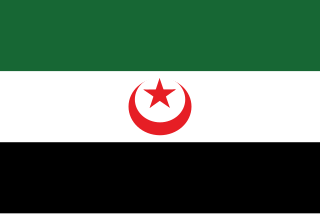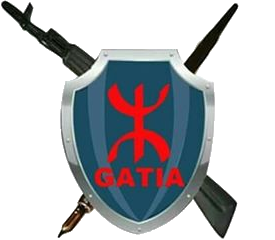
The Arab Movement of Azawad is an Arab military organization active in Azawad/northern Mali. Initially known as the National Liberation Front of Azawad, it was formed in early 2012, during the 2012 Tuareg rebellion. The MAA claims to be a secular, non-terrorist organization, whose main objective is to defend the interests of all the Arab peoples of northern Mali.

The Imghad Tuareg Self-Defense Group and Allies is an armed group in Azawad, Mali. Most of its 500 to 1,000 fighters are Imghad Tuaregs, and the group supports the Malian government.
El Hadj Ag Gamou, born December 31, 1964, in Tidermène, Mali, is an Imghad Tuareg Malian division general. Gamou is currently the governor of Kidal Region since November 22, 2023, and has also been the head of his faction of Imghad Tuareg Self-Defense Group and Allies since the group's foundation. Prior to his governorship, Gamou served in the Malian army, commanding Malian troops against Ansar Dine and the National Movement for the Liberation of Azawad (MNLA) in the early stages of the Mali War.
On July 26, 2017, clashes broke out between the pro-government GATIA Imghad Tuareg militia and anti-government Idnane Tuareg rebels from the Coordination of Azawad Movements.
On July 30, 2016, clashes broke out between GATIA and the Coordination of Azawad Movements in Touzik, Kidal Region, Mali.
The battle of Kidal took place between July 21 and 22, 2016 between GATIA, a pro-government militia consisting of Imghad Tuaregs, against the Coordination of Azawad Movements, consisting of Ifoghas Tuaregs.
The National Alliance for the Protection of Fulani Identity and the Restoration of Justice (ANSIPRJ) was a Fulani nationalist political and military movement formed on June 21, 2016, during the Mali War.
Between December 24–25, 2015, Ansar Dine militants attacked National Movement for the Liberation of Azawad (MNLA) positions in Talahandak, Mali. Ansar Dine captured the MNLA outpost, and then ambushed CMA reinforcements.
On August 17, 2015, clashes broke out between pro-government GATIA militants and rebels from the Coordination of Azawad Movements (CMA) in the town of Anefis and surrounding areas. The dispute was settled in September.
On May 11, 2015, a Malian convoy was ambushed by Coordination of Azawad Movements (CMA) fighters in Tin Telout, Tombouctou Region, Mali. The ambush was the last conflict between the Malian government and CMA before the signing of the Algiers Accords.
On April 29, 2015, clashes broke out in Léré, Mali, between the Malian government and the Coordination of Azawad Movements (CMA) during stalled negotiations for the Algiers Accords.
Between January 16 and 20, 2015, Platform and the Coordination of Azawad Movements clashed in the town of Tabankort, Gao Region, Mali. The clashes sparked a conflict between the CMA and the Dutch contingent of MINUSMA, which led to a controversial demilitarized zone.
Abdou Aïssa, nom de guerre: Sultan Ould Bady, is a Malian jihadist and drug trafficker. He co-founded the Movement for Oneness and Jihad in West Africa (MOJWA) with Hamada Ould Mohamed Kheirou and Ahmed al-Tilemsi, and founded Katibat Salahaddin, a katiba within MOJWA that later reformed in the Islamic State in the Greater Sahara after Bady defected.

On October 16, 2014, clashes broke out between the pro-government GATIA miltiia and the National Movement for the Liberation of Azawad in N'Tillit, Mali.
Between July 19 and 22, 2014, pro-government rebels from GATIA and other militias clashed with rebels from the MNLA, HCUA, and dissident MAA in Tabankort, rural Gao Region, Mali. Clashes were paused after MINUSMA intervened.
On July 11, 2014, clashes broke out between pro-government militias led by GATIA and rebel militias led by the National Movement for the Liberation of Azawad (MNLA) in Anefif, Mali. The battle was the first major confrontation between pro-government militias and rebel groups since the start of the Mali War in 2012.
On October 23, 2013, Katiba Salahadin militants attacked Chadian peacekeepers in the city of Tessalit, sparking a battle between the militants and Chadian and French forces. The attack was the first attack by jihadists targeting MINUSMA peacekeepers during the Mali War.
The Battle of Bourem occurred on September 12, 2023, when the Permanent Strategic Framework for Peace, Security, and Development (CSP-PSD) attacked the Malian Armed Forces and their Wagner Group allies in and around the small town of Bourem. The battle was the first major attack by the CSP-PSD on Malian forces since the Battle of Ber in August 2023.
The Kidal offensive was an offensive by the Malian government and Wagner Group mercenaries against the rebel coalition Permanent Strategic Framework for Peace, Security, and Development (CSP-PSD) with the aim of capturing the rebel-held region of Kidal. The offensive was part of a renewed conflict between the Malian junta that took power in 2021 and former Tuareg rebel groups that had signed the Algiers Agreement in 2015, creating a ceasefire and de facto rebel control over the region. The offensive was also an attempt by Malian forces to seize control over MINUSMA camps in Kidal Region after the Malian junta had ordered the mission to leave the country by the end of 2023.
The battle of Kidal took place between November 10 and 14, 2023, during the Kidal offensive in renewed conflict between the CSP-PSD and the Malian Armed Forces and allied Wagner Group mercenaries during the Mali War. The city of Kidal had been under rebel control since 2014, and the 2015 Algiers Agreement enacted a ceasefire and Kidal Region subsequently was de facto controlled by rebel groups. When Malian and Wagner forces captured the city on November 14, it marked the first time in nine years that all Malian regional capitals were fully under Malian government control.


